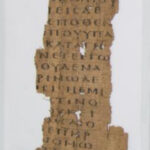| Artefact ID | 376 |
| TM ID | TM 61638 |
| Findspot (DEChriM ID) | 28 (al-Bahnasā) | Class | Textual |
| Material | Papyrus |
| Writing medium | Codex |
| Text content | Literary, Subliterary |
| Language | Greek |
| Description | P.Oxy. XV 1780; Gregory-Aland P39; 𝔓39; NT39 A tall, narrow papyrus fragment containing the 2 Gospel of John 8:14-22. The folio appears to have been torn vertically, thus losing half of the text of the column on both the recto and verso. The text was evidently written by a professional scribe, as the script is considerably large and clear, lacking any corrections or alternations to the text. The ed. pr. notes that there is no punctuation except for the occasional elongated space and only one instance of diaeresis (l. 39, recto). The verso exhibits page number 74 (οδ in Greek alphabetical numbers) and was probably positioned in the left-hand margin, and the ed. pr. posits that the pagination figured on alternating pages, comparing the format to P.Oxy. VII 1011. The suggestion of alternate pagination was later contested, and the page number of the recto is simply assumed lost; see Blumell / Wayment 2015: 57. The format and pagination suggests that the codex probably began with the Gospel of John. |
| Selection criteria | Literary genre (Biblical), Subliterary genre (Liturgical), Nomina sacra |
| Date from | 250 |
| Date to | 299 |
| Dating criteria | Palaeography. Dated to the 4th c. by the ed. pr., but was placed in the late 3rd c. by Turner 1977: 147. Suggestions for the dating have been as early as 200-225 (Comfort / Barrett 2001: 147-149) and 150-200 CE (Jaroš 2006: 948-3954), and a wide-ranging suggestion of 175-399 has been offered by Barker 2009. For the most recent date (275-300), see Clarysse / Orsini 2012: 462 and 470. |
| Absolute/relative date | Relative date |
| Archaeological context | Excavated by Grenfell and Hunt in Oxyrhynchus (el-Bahnasa, Egypt), and donated by the EES (the Egyptian Exploration Society) to Crozer Theological Seminary (now Colgate Rochester Divinity School) in 1922. After being deaccessioned, the fragment was sold at a Sotheby's auction on June 20th 2003 for $350,000 to William Noah before being bought into the Green collection in 2010. The fragment was put up for auction a second time at Sotheby's in 2008, but was not sold, and was donated by the Green collection in 2012 to the Museum of the Bible. The fragment is currently part of an exhibition in the Museum of the Bible, Washington DC. |
| Accession number | Washington, Museum of the Bible, 116; Previously belonged to Crozer Theological Seminary, the Green Collection, and the Ambrose Swasey Library (Rochester, inv. no. 8864) |
ARTEFACT IDENTIFIERS
Editio princeps:
• Hunt, Arthur S. 1922. The Oxyrhynchus Papyri, part XV. Published by the Egypt Exploration Society in Graeco-Roman Memoirs. London. 7-8, no. 1780.
Additional bibliography:
• Aland, Kurt. 1967. Studien zur Überlieferung des Neuen Testaments und seines Textes. Berlin, Boston: De Gruyter. 105.
• Aland, Kurt. 1976. Repertorium der griechischen christlichen Papyri: 1. Biblische Papyri: Altes Testament, Neues Testament, Varia, Apokryphen. Neues Testament 39.
• Barker, Don. 2009. "How long and old is the codex of which P.Oxy 1353 is a leaf?". Jewish and Christian Scripture as artifact and canon. Evans, Craig. A. and H. Daniel Zacharias, eds. London: T&T Clark. 192-202.
• Bell, Lonnie D. 2018. "The Early Textual Transmission of John". NTTSD 54. 168-180.
• Blumell, Lincoln H. and Thomas A. Wayment. 2015. Christian Oxyrynchus: Texts, Documents and Sources. Waco, Texas. Papyrus no. 11.
• Chapa, Juan. 2012. “The Early Text of the Gospel of John”. The Early Text of the New Testament. Hill, Charles E. and Michael J. Kruger, eds. Oxford: Oxford University Press. 154.
• Comfort, Philip W. and David P. Barrett. 1999. The complete text of the earliest New Testament manuscripts. Grand Rapids, Michigan. 137-139.
• Comfort, Philip W. and David P. Barrett. 2001. The Text of the Earliest New Testament Greek Manuscripts: A Corrected, Enlarged Edition of The Complete Text of the Earliest New Testament Manuscripts. Wheaton: Tyndale House. 147-149.
• Clarysse, Willy and Pasquale Orsini. 2012. "Early new testament manuscripts and their dates: A critique of theological palaeography". Ephemerides Theologicae Lovanienses 88. 443-474.
• Head, Peter M. 2004. "The Habits of New Testament Copyists Singular Readings in the Early Fragmentary Papyri of John". Biblica 85 (3). 406.
• Jaroš, Karl. 2006. Das Neue Testament nach den ältesten griechischen Handschriften (CD-Rom). 3948-3954, no. 2.25.
• Luijendijk, Anne-Marie. 2010. “Sacred Scripture as Trash: Biblical Papyri from Oxyrhynchus”. Vigiliae Christianae 64. 217–254, especially page 247-248. (de luxe copy, probably for liturgical use)
• Mazza, Roberta. 2015. "Papyri, Ethics, and Economics: A Biography of P.Oxy. 15.1780 (P39)". BASP 52. 113-142.
• Robinson, Maurice. 2001. "Review of P. W. Comfort and D. P. Barrett (eds.), The Text of the Earliest New Testament Greek Manuscripts". TC: A Journal of Biblical Textual Criticism 6. Link: http://rosetta.reltech.org/TC/vol06/CB2001rev.html
• Turner, Eric G. 1977. The Typology of the Early Codex. Pennsylvania: University of Pennsylvania Press. 147.
• van Haelst, Joseph. 1976. Catalogue des papyrus littéraires juifs et chrétiens. Description no. 448.


 Json data
Json data




